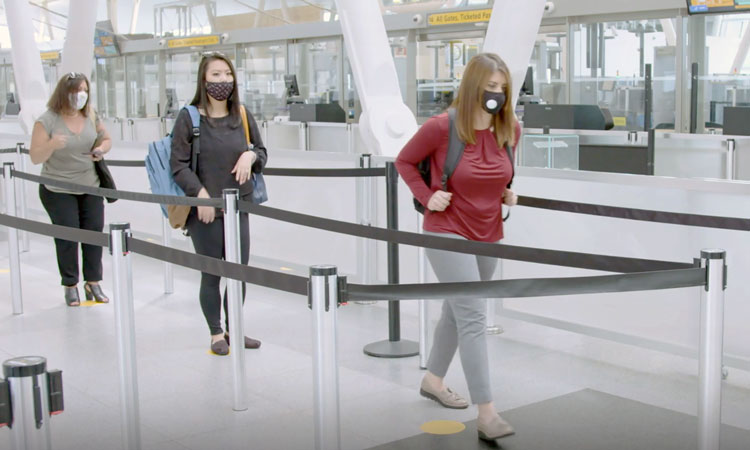Preparing JFK’s T4 for the new normal of air travel
- Like
- Digg
- Del
- Tumblr
- VKontakte
- Buffer
- Love This
- Odnoklassniki
- Meneame
- Blogger
- Amazon
- Yahoo Mail
- Gmail
- AOL
- Newsvine
- HackerNews
- Evernote
- MySpace
- Mail.ru
- Viadeo
- Line
- Comments
- Yummly
- SMS
- Viber
- Telegram
- Subscribe
- Skype
- Facebook Messenger
- Kakao
- LiveJournal
- Yammer
- Edgar
- Fintel
- Mix
- Instapaper
- Copy Link
Posted: 26 July 2021 | Roel Huinink | No comments yet
Roel Huinink, President and CEO of JFKIAT, speaks to International Airport Review about how the airport has integrated camera-enabled technology into their airport operations, which provides real-time alerts on social distancing and indicates where resources and staff are best deployed.


Since the beginning of the COVID-19 pandemic, the aviation industry has been transformed. As JFK International Air Terminal LLC (JFKIAT), the operator of Terminal 4 (T4) at John F. Kennedy International Airport (JFK) – the largest international air terminal in New York City – innovating our operations and processes was a necessity to weather the impacts of the crisis. At JFKIAT, a cornerstone of our mission is to provide a best-in-class customer experience and ensure the highest levels of safety and security, and we have worked tirelessly to bring that mission into every aspect of our work at T4. Reinforcing that mission became a critical aspect of our efforts to keep T4 safe throughout the pandemic.
Since January 2020, we had managed the impacts of COVID-19 on arriving flights from Asia, working closely with our partners at the Port Authority of New York and New Jersey (PANYNJ), our government agency partners and our business partners to gather the most up-to-date information on the virus and take immediate action within T4. When travel between the United States and Europe was suspended on 11 March 2020, the announcement put into context how quickly the virus was spreading in the U.S., and how much the pandemic would impact travel around the world, possibly for months to come. In very short order, we were confronted with the imminent need to transform several aspects of our terminal’s operations, safety procedures and passenger journey.
Transitioning from a reactive to a proactive stance
Throughout the course of the pandemic, T4 remained open 24/7, and it was of utmost importance to keep our customers and employees safe during a very uncertain time. We continued to work closely with PANYNJ to stay aligned and put the latest guidance from the state and federal government into action. In spring of 2020, when the need to make longer-term decisions for the terminal’s safety became more imminent, we developed a comprehensive COVID-19 plan, building upon what we had learned in the first few months of the crisis to move from a reactive to a proactive position and prepare for the future.
We assigned dedicated teams to focus on five key areas: hygiene and sanitation; health and wellbeing; social distancing; transactions; and communications. Each project team focused on specific challenges – from anxiety around high‑touch areas within the terminal to communicating safety measures to customers and staff – and developed targeted solutions around each challenge. With the launch of the plan, we sought to innovate beyond standard air terminal practices in order to look ahead to the future, addressing anxiety, ensuring the highest level of safety practices and leveraging cutting edge technology to prepare T4 for the new normal of air travel.
Using AI to monitor social distancing
For social distancing, we took a number of factors into account to ensure a safe environment for customers and employees alike. In July 2020, we announced our partnership with CrowdVision to launch camera-enabled technology to monitor social distancing, making T4 the first air terminal in North America to launch this technology.
In the course of our first conversations with CrowdVision, the company informed us that it was developing SafeDistance technology as a way to bring an added level of safety to the terminal. JFKIAT had already worked with the company on camera‑based video analytics to help measure a variety of metrics within T4, including the number of passengers, operational resources, queue times and more. CrowdVision’s new SafeDistance feature would help to maintain a safe and healthy terminal by providing real-time alerts on customer separation (how far apart individuals were from one another). The implementation of SafeDistance technology allowed our operations team to identify areas within the terminal that were too crowded and pinpoint places where people needed to be dispersed or re-organised to prevent any extended period of overcrowding or overexposure.
Implementing camera-enabled technology
Throughout the rollout of the new technology, our partnership with CrowdVision has proven to be a productive one. “We are delighted to extend the relationship with JFKIAT by supplementing the CrowdVision people movement operational data with the new SafeDistance metrics and alerts,” said Stuart Mills, CrowdVision’s Chief Operating Officer. Having access to the highly accurate and actionable data, both in real-time and historically, underpins JFKIAT’s strong vision to keep passengers and staff safe.
To launch the technology, we worked with CrowdVision to install 127 commercial off-the-shelf (COTS) cameras in specific areas of the terminal that would provide video analytics and help us to understand movement and flow of customers and employees throughout the building. Having access to CrowdVision’s real-time data helped us to analyse spots within the terminal that are the most susceptible to potential crowding, giving employees the ability to make changes necessary to limit crowds and better support those customers with a smooth and safe experience. In the short‑term, it has helped us to relay information to our partners, including the Transportation Security Administration (TSA), to determine how many lanes should be open at security and reduce wait times for passengers. It has also helped us to create a more seamless flow for queues and ensure social distancing practices.
A long-term strategy to ease crowding
Now that we have used the technology within T4 for several months, we are approaching a point at which we will have enough metrics available to validate the data that we have collected around social distancing challenges at different locations in the terminal. While we have used the technology in real-time to disperse individuals on an as-needed basis, we can begin to develop longer-term initiatives to address crowding within specific areas where we are finding trends. We are also working with CrowdVision to come up with specific solutions in different types of areas within the terminal, such as in queues and at gates, and determine the best ways to work with our partners to execute processes that keep passengers and employees as safe as possible in these areas.
JFKIAT continues to invest in additional technology and innovation to elevate safety and security at T4. We are in the initial stages of exploring artificial intelligence (AI) based systems to monitor airside operations, manage operational performance and ensure safety practices. Through our important collaboration with PANYNJ, we continue to find ways to make our customer journey as contactless as possible.
Our partnership with CrowdVision gave us an opportunity to test, gather information from and optimise new technology to benefit customers and employees at T4. But our work is not yet done; as we continue to use the technology, we will apply the knowledge that we have gained to evolve our safety practices in the long-term. The impacts of the pandemic are continuing to reverberate across the aviation industry, and it is becoming apparent that more changes, adjustments and transformation will be necessary to keep travellers and employees safe. As we look ahead, finding innovative solutions to the challenges that we face – and determining how to apply them in the future – will be key to restoring passenger confidence in air travel.


Issue
Related topics
Contactless / Touchless technology, COVID-19, New technologies, Passenger experience and seamless travel, Safety, Terminal operations
Related airports
Related organisations
CrowdVision, JFK International Air Terminal LLC (JFKIAT), Port Authority of New York and New Jersey (PANYNJ)


















